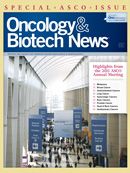Publication
Article
Oncology & Biotech News
Exemestane Is a New Option for Prevention of Breast Cancer in Postmenopausal Women
Author(s):
Postmenopausal women at risk of breast cancer got good news from the MAP.3 trial results: Exemestane reduced their risk of invasive breast cancer by 65% compared with placebo.

Paul E. Goss, MD, PhD
Postmenopausal women at risk of breast cancer got good news from the MAP.3 trial results reported at the ASCO annual meeting in June: Exemestane reduced their risk of invasive breast cancer by 65% compared with placebo. Exemestane also reduced the risk of known breast cancer precursor lesions, including ductal carcinoma in situ, lobular carcinoma in situ, atypical ductal hyperplasia, and atypical lobular hyperplasia, which would suggest further reductions in invasive cancers as time goes by. These benefits were achieved without any increase in the incidence of any serious side effects compared to placebo, including osteoporosis and clinical fracture, cardiovascular events, and second malignancies, or treatment-related deaths.
“It is extraordinary that we can reduce the incidence of breast cancer by 65%,” said lead author Paul E. Goss, MD, PhD, director of breast cancer research at Massachusetts General Hospital’s Cancer Center in Boston. “That is a massive benefit. In our opinion, exemestane represents a new option for consideration of breast cancer prevention for postmenopausal women who meet the criteria of the MAP.3 trial. This study provides a rationale for wider implementation of preventive use of exemestane.”
The study enrolled 4560 postmenopausal women between 2004 and 2010 who were aged >37 years (median age, 62 yr) with at least 1 risk factor for breast cancer (aged >60 yr, Gail score >1.66%, prior atypical ductal hyperplasia, and atypical lobular hyperplasia). At baseline, median Gail score was 2.3% and average body mass index (BMI) was 28 kg/m2. About half of the participants were aged >50 years, 40% had a Gail score >1.66%, and 11% had prior intraepithelial neoplasia.
During the 3-year follow-up, 11 cases of breast cancer were diagnosed in the exemestane arm versus 32 in the placebo arm. The benefit of exemestane was in the reduction of estrogen receptor—positive tumors (7 in the exemestane arm vs 27 in the placebo arm) and in HER2-negative tumors (10 and 26, respectively).
The superiority of exemestane to placebo was evident across all risk groups, including Gail score, age, BMI, prior lobular carcinoma in situ, and prior ductal carcinoma in situ.
Side effects that were increased with exemestane included hot flashes, fatigue, insomnia, gastrointestinal effects, and arthritis. Hot flashes occurred in 40% of women treated with exemestane and 32% of those in the placebo groups. The incidences of bone fracture, osteoporosis, cardiovascular events, and other malignancies were similar in both arms.
At an ASCO press conference, Goss told the media that only 4% of eligible women take tamoxifen, which carries serious, but relatively rare, risks of venous thromboembolism and endometrial cancer. Exemestane is about to go off-patent, which should make the drug cheaper, but it is not approved for prevention in women who have not had breast cancer. Goss said that it is not clear whether Pfizer will try to file for the prevention indication.
Goss PE, Ingle JN, Ales-Martinez J, et al. Exemestane for primary prevention of breast cancer in postmenopausal women: NCIC CTG MAP.3—a randomized placebo- controlled clinical trial. J Clin Oncol. 2011;29(suppl; abstr LBA504).










